
[Source: Alan Young]
Cockermouth Station Gallery 1: 1894 - c.1916 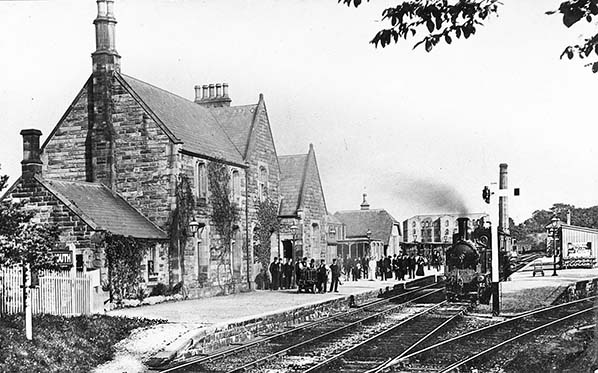 In 1894 at the down (island) platform the locomotive cannot be positively identified but is most probably an LNWR Webb 'Coal Tank' 0-6-2. It is attached to what appears to be a single passenger carriage with centre brake compartment. Both are wearing LNWR livery. On the up platform the handsome stone building is shown clearly with the later refreshment room beyond. One wonders what exactly was happening when the photograph was taken. Why the large number of persons on the opposite platform, yet only staff on the platform with the train? The likely answer is that people were positioned deliberately on the main platform to suit the photographer. Perhaps this was some special occasion; after all, why just an apparently single carriage? Could it have been a VIP visit? The locomotive is in pristine condition, suggestive of a VIP visit although it might have simply been brand new at the time. To the left of the locomotive a rake of cattle wagons can be seen while in the distance stand two rakes of open wagons, those to the right being ore wagons. The distant tall building is A & H Rea’s Atlas Confectionery Works. By 1913 the factory was managed by J A Forrester and manufacturing ‘cycle cars’ (small 3-or-4-wheeled cars with motorcycle features). This enterprise appears to have failed as the works closed and the building was demolished in 1918.
Copyright photo from John Alsop and A G Ellis collections  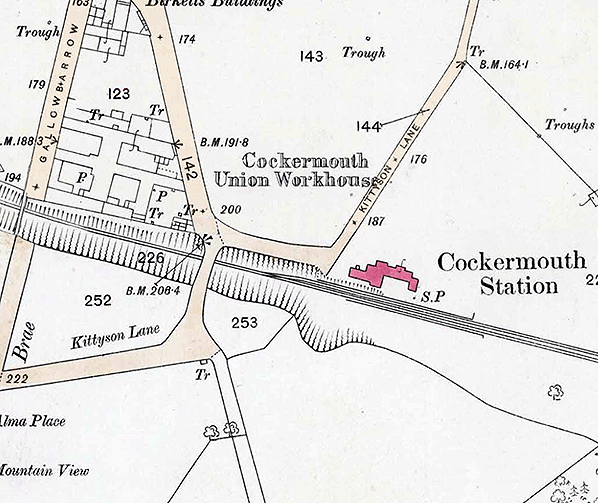
1866 1: 2,500 OS map. The Second Cockermouth station opened in 1865. This map was revised in 1863 and published in 1866 so the limited detail of the station site, showing only the main building and location of the two platforms, is presumably a late addition. Bowtell (1989) asserts that the station originally possessed only the north platform but two platforms are shown here. Click here for a larger version.
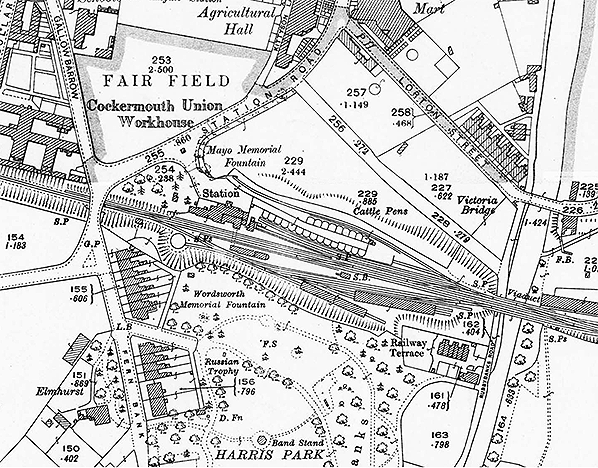
1923 1: 2,500 OS map. Cockermouth station is shown in its prime. The station building and up platform are north of the running lines with sidings trailing in from the cattle loading dock and pens. The island platform is shown with its more modest buildings and a signal box towards the east end. Sidings to the south of the running lines serve a two-road carriage shed, a one-road goods shed and a turntable. Double track ends a short distance west of the bridge under Station Road. Apart from livestock all goods traffic was handled at the site of the original Cockermouth station, and this would continue until the closure of the route through Cockermouth to all goods traffic in 1964. Click here for a larger version.
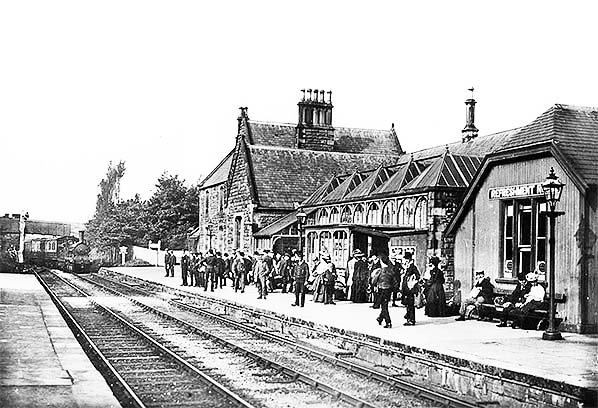 Looking west at Cockermouth station circa mid 1890s. The eclectic mixture of architecture will be noted: the original stone building of Gothic style; the elaborate timber and glass screen of the waiting area; and the more utilitarian design of the refreshment room added in 1890. The train is probably stationary for the purposes of the camera. Other than it being an 0-6-0 tender type it is too far away to be positively identified; it is probably a ‘Cauliflower’ (as seen on many other photos of stations on this route) but could also be a DX Class machine. The DX was another goods class but in 1881 or thereabouts a number were rebuilt for working passenger trains. The coaching stock wears LNWR Plum and White livery and appears to be either four- or six-wheel types or a mix of both; given that this is almost certainly a Victorian view it is unlikely that any other (bogie) types would be in normal service on this line.
Copyright photo from John Alsop collection 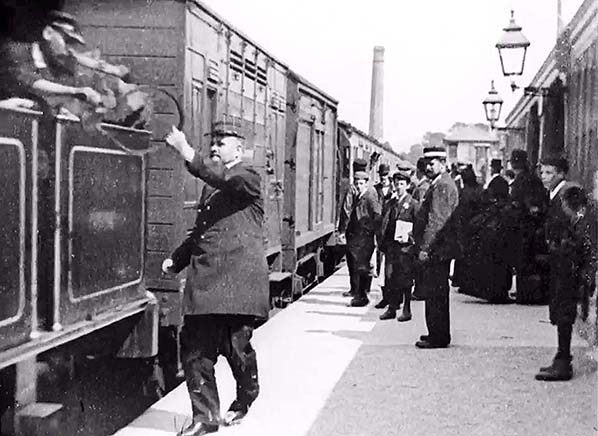
The single line token is exchanged as a Webb 4ft 6in 2-4-2T pulls into the down platform at Cockermouth station in 1899. Note the L&NWR horsebox behind the loco. The tall chimney of Tweed Mill, by now The Atlas Confectionery Works, is seen in the background.
Photo from James Lake collection 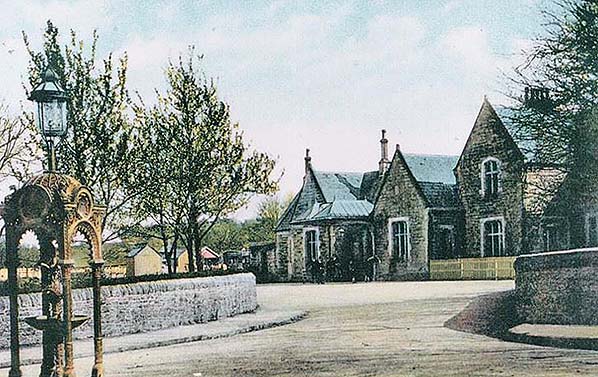 Tinted postcard from the first decade of the 20th century showing Cockermouth station approach road and forecourt seen from Station Road. The Mayo Memorial fountain stood in the middle for the approach road at its junction with Station Road. The fountain was erected at the junction of Station Road and Cockermouth station approach road as a memorial to Richard Southwell Bourke, sixth Earl of Mayo, M.P. for Cockermouth from 1857 - 1868 after he was assassinated in1872, while visiting the Andaman Islands as Viceroy and Governor-General of India. The fountain was removed when a war memorial which still stands was erected at the junction in 1922. Tinted postcard from the first decade of the 20th century showing Cockermouth station approach road and forecourt seen from Station Road. The Mayo Memorial fountain stood in the middle for the approach road at its junction with Station Road. The fountain was erected at the junction of Station Road and Cockermouth station approach road as a memorial to Richard Southwell Bourke, sixth Earl of Mayo, M.P. for Cockermouth from 1857 - 1868 after he was assassinated in1872, while visiting the Andaman Islands as Viceroy and Governor-General of India. The fountain was removed when a war memorial which still stands was erected at the junction in 1922.Photo from John Mann collection 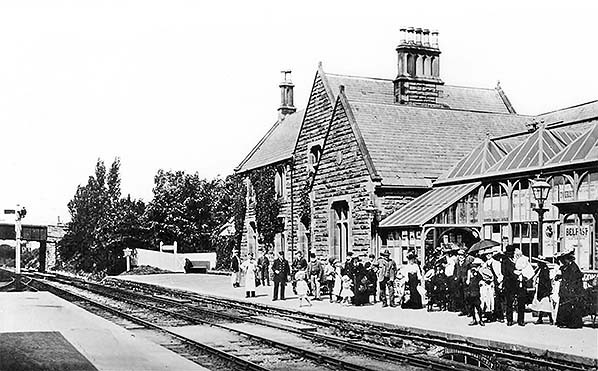
This photo can be dated as earlier than July 1908. Numerous intending passengers are awaiting an eastbound train at Cockermouth station. To the original Gothic, stone-built (and ivy-clad) building an elaborate glazed screen and porch has been added, producing a highly distinctive elevation. The platform masonry in the foreground is interrupted by the segmental-arched window of the subway.
Copyright photo from John Alsop collection 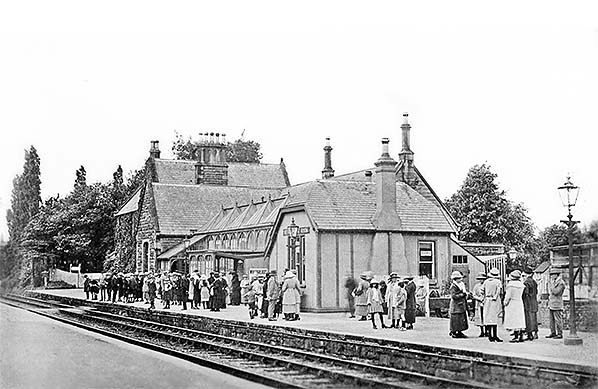
The up platform is crowded with smartly attired passengers waiting for a train towards Keswick c1908. The handsome Gothic architecture of the original station building has been enriched by the addition of a timber and glass screened waiting area and the refreshment room under its half-hipped roof at
the near end. Copyright photo from John Alsop collection 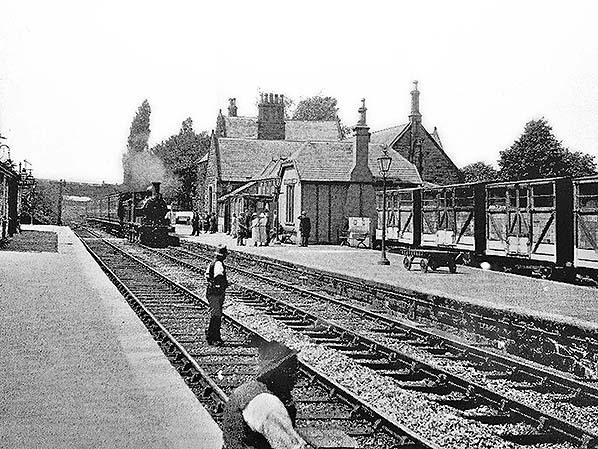 Permanent way workers stand on the down line as a passenger train hauled by an Webb 0-6-0 18in goods class ‘Cauliflower’ pulls into the up platform. The cauliflower nickname came from the LNWR crest mounted on the centre splasher, it being said to resemble a cauliflower when viewed from a distance. Although a designed as a goods loco they spent much of their time on passenger workings. At least four LNWR cattle wagons stand in the up siding alongside the cattle dock. The third wagon from the bufferstop looks like a Diagram 20 'small cattle wagon' as the LNWR classified them. These wagons had all been withdrawn by 1918 according to the L&NWR Society. This, therefore, would provide a latest possible date for the photo. Photo from John Mann collection Click here for Cockermouth Station Gallery 2:
|

 The Cockermouth, Keswick & Penrith Railway (CK&P) chose not to use the existing station at Cockermouth which had been opened in April 1847 as the eastern terminus of the Cockermouth & Workington Railway (CW).
The Cockermouth, Keswick & Penrith Railway (CK&P) chose not to use the existing station at Cockermouth which had been opened in April 1847 as the eastern terminus of the Cockermouth & Workington Railway (CW).  The main passenger facilities at Cockermouth (2nd / Joint) station were on the up (north) platform – the side closest to the town centre. Bowtell (1989) states that his was originally the only platform, but it proved inadequate and an island platform reached via a subway was added within ten years; however the OS plan published in 1866 shows two platforms at the station; however the OS plan published in 1866 shows two platforms at the station. Built of coursed stone under slate roofs, the stationmaster’s house stood west of the station building and set back slightly from it. The two-storey house was Gothic in character, presenting a gable to the platform at its east end. The door and window openings were rectangular but stepped in to create a flattened arch. The station building, contiguous with the stationmaster’s house, was of the same style and at its western end a tall gabled section contained the stationmaster’s office (and, originally, a boardroom). Beyond this were the booking hall, waiting rooms and porters’ room. Although no platform canopy was provided, a highly attractive and most distinctive shelter in timber and glass fronted the station building, recessed behind the gable of the office. East of the pent-roofed timber entrance to the booking hall, the shelter was lit by eight arched windows and the five hipped, glazed gables of its roof. In 1890 a timber-built refreshment room under a hipped roof was added as an east wing; this replaced the rented room used since 1868. The northern (forecourt) elevation of the buildings was lively in appearance.
The main passenger facilities at Cockermouth (2nd / Joint) station were on the up (north) platform – the side closest to the town centre. Bowtell (1989) states that his was originally the only platform, but it proved inadequate and an island platform reached via a subway was added within ten years; however the OS plan published in 1866 shows two platforms at the station; however the OS plan published in 1866 shows two platforms at the station. Built of coursed stone under slate roofs, the stationmaster’s house stood west of the station building and set back slightly from it. The two-storey house was Gothic in character, presenting a gable to the platform at its east end. The door and window openings were rectangular but stepped in to create a flattened arch. The station building, contiguous with the stationmaster’s house, was of the same style and at its western end a tall gabled section contained the stationmaster’s office (and, originally, a boardroom). Beyond this were the booking hall, waiting rooms and porters’ room. Although no platform canopy was provided, a highly attractive and most distinctive shelter in timber and glass fronted the station building, recessed behind the gable of the office. East of the pent-roofed timber entrance to the booking hall, the shelter was lit by eight arched windows and the five hipped, glazed gables of its roof. In 1890 a timber-built refreshment room under a hipped roof was added as an east wing; this replaced the rented room used since 1868. The northern (forecourt) elevation of the buildings was lively in appearance.
 The new island platform was served by an independent down platform line and a loop platform line. A lengthy single-storey, pent-roofed timber building stood towards the west end of this platform; part was open-fronted and part was enclosed and glazed to offer shelter to passengers. As noted above, a subway connected the platforms. The signal box was installed in 1875 immediately beyond the ramp at the eastern end of the island platform. The box and its 40-lever frame were provided by the Saxby company.
The new island platform was served by an independent down platform line and a loop platform line. A lengthy single-storey, pent-roofed timber building stood towards the west end of this platform; part was open-fronted and part was enclosed and glazed to offer shelter to passengers. As noted above, a subway connected the platforms. The signal box was installed in 1875 immediately beyond the ramp at the eastern end of the island platform. The box and its 40-lever frame were provided by the Saxby company.  Being owned jointly by the CW and CK&P, Cockermouth station staff were ‘joint’ employees until the two companies were swallowed up by the new London, Midland & Scottish Railway (LMS) in 1923. In addition to the stationmaster, the staff included booking, parcels and telegraph clerks, a foreman porter and colleagues on the platform as well as signalmen. The first stationmaster, and occupant of the house, was Joseph Wales, who was in post until 1870 after which he was appointed accountant to the CK&P. He was followed by Mr Mitchell, promoted from booking clerk at the station, and in 1881 Mr W Cook became stationmaster until 1886 when he was transferred to the LNW’s Greenore terminus in Ireland. Mr R A Holt was in post at Cockermouth from 1887 until 1891, and his successor was Robert Little (seen on the accompanying photo of the staff) who remained at the station until 1921 when Mr J W Ewart – previously at Bassenthwaite Lake and Embleton – continued moving west and became Cockermouth’s stationmaster. He was promoted by the LMS in 1924 and transferred to Keswick.
Being owned jointly by the CW and CK&P, Cockermouth station staff were ‘joint’ employees until the two companies were swallowed up by the new London, Midland & Scottish Railway (LMS) in 1923. In addition to the stationmaster, the staff included booking, parcels and telegraph clerks, a foreman porter and colleagues on the platform as well as signalmen. The first stationmaster, and occupant of the house, was Joseph Wales, who was in post until 1870 after which he was appointed accountant to the CK&P. He was followed by Mr Mitchell, promoted from booking clerk at the station, and in 1881 Mr W Cook became stationmaster until 1886 when he was transferred to the LNW’s Greenore terminus in Ireland. Mr R A Holt was in post at Cockermouth from 1887 until 1891, and his successor was Robert Little (seen on the accompanying photo of the staff) who remained at the station until 1921 when Mr J W Ewart – previously at Bassenthwaite Lake and Embleton – continued moving west and became Cockermouth’s stationmaster. He was promoted by the LMS in 1924 and transferred to Keswick.  In 1919 the decision was made to erect the town’s Great War memorial at the edge of the station forecourt. The station was thriving when it became part of the LMS in 1923, but in the 1930s, here as elsewhere on the railways of Britain, a decline in traffic set in. At Cockermouth the refreshment room closed in the mid 1930s and was dismantled. The structure of the station’s signal box had been modified over the years, and in either 1935 or 1941 the LMS installed a 45-lever frame to replace the original one.
In 1919 the decision was made to erect the town’s Great War memorial at the edge of the station forecourt. The station was thriving when it became part of the LMS in 1923, but in the 1930s, here as elsewhere on the railways of Britain, a decline in traffic set in. At Cockermouth the refreshment room closed in the mid 1930s and was dismantled. The structure of the station’s signal box had been modified over the years, and in either 1935 or 1941 the LMS installed a 45-lever frame to replace the original one.  In 1948 the LMS lines in England and Wales became the London Midland Region (LM) of the new, nationalised British Railways (BR). The LMS era had seen no significant modernisation of Cockermouth station’s facilities, although the company’s ‘hawkeye’ nameboards were fitted. The turntable was removed 1954/55 at the time when passenger trains ceased to be steam-hauled. Thomas Hughes, the last stationmaster of Cockermouth, was appointed in 1955; he remained in post until the station closed.
In 1948 the LMS lines in England and Wales became the London Midland Region (LM) of the new, nationalised British Railways (BR). The LMS era had seen no significant modernisation of Cockermouth station’s facilities, although the company’s ‘hawkeye’ nameboards were fitted. The turntable was removed 1954/55 at the time when passenger trains ceased to be steam-hauled. Thomas Hughes, the last stationmaster of Cockermouth, was appointed in 1955; he remained in post until the station closed.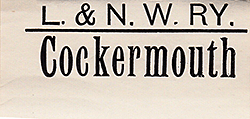 In the late 1950s the appearance of the station was modestly updated by the installation of BR(LM) signage, including vitreous enamel nameboards and totem lamp plates. Gas lighting remained in use. Although traffic was in decline, and in 1959 closure of the line was contemplated, Cockermouth station remained attractive and well maintained.
In the late 1950s the appearance of the station was modestly updated by the installation of BR(LM) signage, including vitreous enamel nameboards and totem lamp plates. Gas lighting remained in use. Although traffic was in decline, and in 1959 closure of the line was contemplated, Cockermouth station remained attractive and well maintained.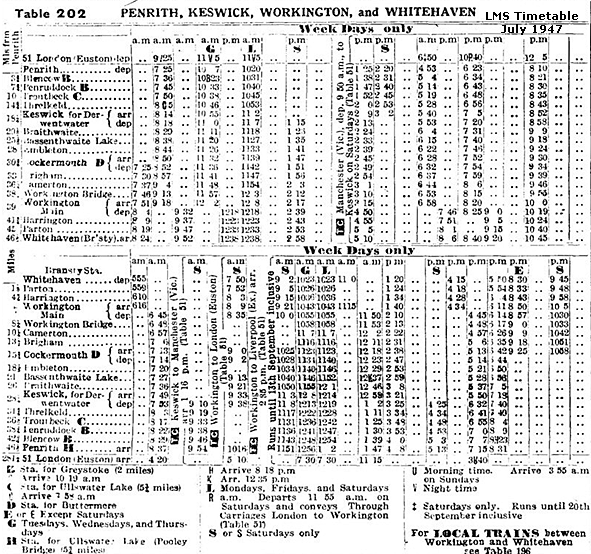
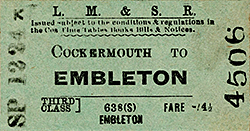 A proposal to withdraw all passenger services was published on 5 July 1963 and followed the usual TUCC procedure. In late December 1966 Barbara Castle became Minister of Transport and one of her early decisions, announced on 10 January 1966, was that the route should be closed between Workington and Keswick – the section including Cockermouth - but the remainder of the line to Penrith should be retained in view of the hardship which would be suffered by users of that section of the route. There was surprisingly little public outcry at this announcement, and the last trains ran between Workington and Keswick on 16 April 1966 and on 18 April Cockermouth for Buttermere station and its signal box closed. Happily, a few of the stations named in The Slow Train did not close, so such places as Ambergate, St Ives (Cornwall) and Chester-le-Street can still be reached by train.
A proposal to withdraw all passenger services was published on 5 July 1963 and followed the usual TUCC procedure. In late December 1966 Barbara Castle became Minister of Transport and one of her early decisions, announced on 10 January 1966, was that the route should be closed between Workington and Keswick – the section including Cockermouth - but the remainder of the line to Penrith should be retained in view of the hardship which would be suffered by users of that section of the route. There was surprisingly little public outcry at this announcement, and the last trains ran between Workington and Keswick on 16 April 1966 and on 18 April Cockermouth for Buttermere station and its signal box closed. Happily, a few of the stations named in The Slow Train did not close, so such places as Ambergate, St Ives (Cornwall) and Chester-le-Street can still be reached by train.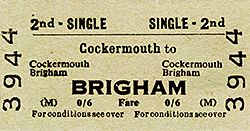 The timber building on the island platform and the signal box had been demolished by 1968 but the stationmaster’s house and station building survived until November 1975. The platforms were demolished by 1980 The town’s fire and rescue headquarters was constructed on the site in the early 1980s; an adjacent fire station opened in 2002. The fire and rescue headquarters closed in xxxxxx and was sold to a property developer in 2015. He is planning a housing and retirement development for the 3.8 acre site. Work has already started to convert the HQ building into 23 apartments. The adjacent fire station remains open for now.
The timber building on the island platform and the signal box had been demolished by 1968 but the stationmaster’s house and station building survived until November 1975. The platforms were demolished by 1980 The town’s fire and rescue headquarters was constructed on the site in the early 1980s; an adjacent fire station opened in 2002. The fire and rescue headquarters closed in xxxxxx and was sold to a property developer in 2015. He is planning a housing and retirement development for the 3.8 acre site. Work has already started to convert the HQ building into 23 apartments. The adjacent fire station remains open for now.




 Home Page
Home Page